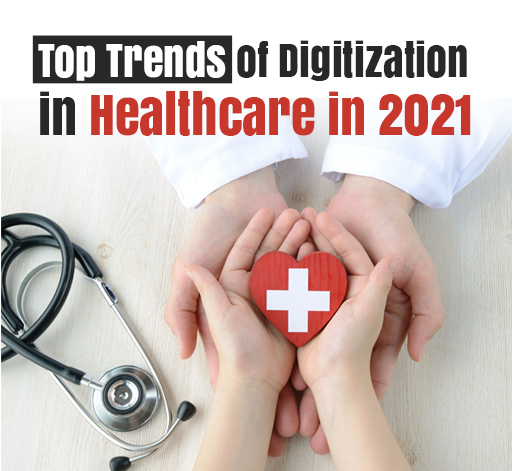With the world taking a total 360° turn within the span of the past 2 years, the work culture has been redefined once again. The onslaught of pandemic, though has placed the world in the back seat, but also is responsible for further revolutionising the entire health care globally.

As we enter into the second half of the 2021, one can easily witness the changes in the use of technology, specifically in the healthcare system. Let us look at the top 3 current trends in regards to the digitization of health care in 2021.
1. Telemedicine and telehealth
The year 2020 brought a lot of storming changes corresponding to the viral spread. The health care industry was one of the first one’s to face a hardcore setback and extreme challenges. With the rising number of patients, even the most advanced medical institutions faced difficulty in managing this gargantuan patient influx and catering to them with the required attention. Along with them, there was also a huge number of people suffering from chronic diseases who hesitated to visit the hospital for their routine checkups in fear.
It was during this time that the Information and Communication Technology was brought in use, causing the rise of telemedicine as a solution amidst the on-going crisis. Its use allowed doctors to provide the best-quality treatment at various stages directly to the patients' homes through the internet. Telemedicine and telehealth have significantly resolved the struggles of patients as well as the doctors at various stages.
2. Use of AI in evaluating patients’s progress
Artificial Intelligence (AI) is not just a digital transformation trend but a rapid increasing practice for medical innovations and related investors.
Japanese hospitals have already been using robotic nurses like Paro, Pepper, and Dinsow however, recently there are also plenty of American versions too, like Moxi, a friendly hospital droid designed for assisting human nurses with routine tasks. Chatbots and virtual health assistants are another AI-based technology that patients are becoming familiar with.
The most effective use of AI comes into play in the arena of precision medicine, medical imaging, drug discovery, and genomics.
3. Emerging Healthcare Apps and Wearable Devices
Self-monitoring apps and wearable devices, including exercise trackers, heart rate sensors, and sweat meters, allow chronic patients to record their vitals and share them with their doctors conveniently. Today, diabetic patients can monitor the sugar and oxygen levels in their blood at the click of a button without visiting doctors.
During this digital age, patients are focusing on prevention and maintenance of their health while constantly demanding information about their health.
As a result, healthcare companies are being proactive by investing in wearable technology devices that can provide up-to-date monitoring of high-risk patients to determine the likelihood of a major health event. Some of the most common of these devices include: Heart rate sensors, Exercise trackers, Sweat meters (for monitoring blood sugar levels), Oximeters for monitoring the amount of oxygen carried in the blood, and used by patients with respiratory illnesses).
Conclusion
With all these trends currently in practice along with the healthcare industry have been proven extremely effective. However, these are not only trends, there are even more upcoming trends like that of big data and blockchain data tools are also getting extremely populars. Therefore, the current students who will be working in these fields in the next 3-6 years must have a profound understanding of all these resources to perform their roles as doctors even more effectively.
At Lincoln American University, our trained faculty ensures to evolve at various levels with the emerging needs and trends of the time.

